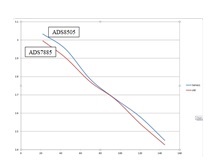Gentlemen,
I am using the ADS8505 as shown in figure 21, page 10 of "SLAS180B-September 2005- Revised June 2007" document. With a -10v analog input, the hex code reading is 0000, at +10v the code is FFFF. This is clearly not what is stated in table 2 "Ideal Input Voltages and Output Codes". Please advise...
By the way, is this part recommended for new design? If not what would you recommend?
Thank you for your help.
Serge Faublas


